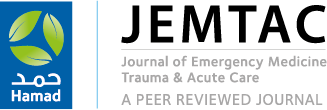-
oa Battle of fluids: Comparing normal saline and lactated ringer’s in diabetic ketoacidosis management—A systematic review and meta-analysis
- Source: Journal of Emergency Medicine, Trauma and Acute Care, Volume 2025, Issue 2, Apr 2025, 18
-
- 04 December 2024
- 06 February 2025
- 08 April 2025
- Previous Article
- Table of Contents
- Next Article
Abstract
Background: Current guidelines recommend the use of normal saline (NS) as the preferred resuscitative fluid in the treatment of diabetic ketoacidosis (DKA). However, due to the development of hyperchloremic metabolic acidosis when using NS, balanced crystalloids such as lactated Ringer’s solution (LRS) and plasma-lyte have been proposed as alternative treatments. Therefore, the current meta-analysis investigated the efficacy and safety of NS compared to LRS in managing DKA.
Methods: A comprehensive literature search directly comparing NS to LRS was conducted on PubMed, MEDLINE, Web of Science, and Google Scholar databases. This search was limited to articles authored in English; however, no time limitation was provided. A random-effects model was used to summarize the mean differences (MD) and their corresponding 95% confidence intervals (CI). Moreover, methodological quality appraisal was performed using Cochrane’s Risk of Bias tool and the Newcastle–Ottawa Scale.
Results: A total of six studies enrolling 50,330 patients with DKA were included. A pooled MD indicated no significant difference in the time to DKA resolution between the NS and LRS groups (MD: 1.12; 95% CI: −0.69 to 2.93; p = 0.23). Similarly, no significant difference was observed between the two groups in terms of the total volume of fluids administered (MD: 436.57; 95% CI: −280.92 to 1154.06; p = 0.23) and length of hospitalization (MD: −0.01; 95% CI: −0.53 to 0.50; p = 0.96). However, the pooled data indicated that the duration of intensive care unit (ICU) stay was significantly shorter in the LRS group (MD: 4.79; 95% CI: 1.98 to 7.59; p = 0.0008). Similarly, patients who received LRS showed significantly higher levels of post-resuscitation bicarbonate and lower levels of post-resuscitation chloride than those who received NS (MD: −1.22; 95% CI: −1.67 to −0.77; p < 0.00001 and MD: 4.74; 95% CI: −0.23 to 9.25; p = 0.04, respectively).
Conclusion: LRS was as effective as NS in resolving DKA. Therefore, LRS can be considered as an alternative treatment option for DKA.



